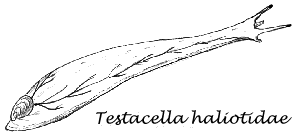Testacella: Not So Shy in Olney
My garden in Olney is a haven for Testacella. They are said to be very hard to find but, while forking the earth, I have discovered, without effort, four Testacella haliotidae and one T. scutulum.
The family Testacellidae (shelled slugs) has only one genus comprising three species. I've yet to encounter T. maugei.
The habitat of these carnivorous slugs is mostly cultivated soil. They remain underground or in leaf litter searching out earthworms although they also prey on other soil invertebrates including slugs.
 The
mouth cavity of a slug contains a radula which
projects from its floor. The radula is a flexible
strap like organ bearing hard, pointed teeth. In most snails the radula acts like a rasp but in Testacella
it is a grasping organ.
The
mouth cavity of a slug contains a radula which
projects from its floor. The radula is a flexible
strap like organ bearing hard, pointed teeth. In most snails the radula acts like a rasp but in Testacella
it is a grasping organ.
When Testacella makes contact with a worm it pushes the radula out of its mouth. The walls of a groove in the radula diverge and clamp round the body of the prey. Webb (1893) likened this action to a spring trap. The prey is ingested slowly taking several hours for a large earthworm.
I observed two shelled slugs feeding on earthworms. In both cases the anterior portion of the worm had been ingested and fairly rigorous pulling, on my part, failed to release the prey. It appears that once a meal is started it must continue until it is completed.
These slugs are distinctive. T. haliotidae is generally creamy white and T. scutulum is generally yellow. The most noticeable feature is a small flat shell at the posterior of the body which covers the mantle. The tentacles are more pointed than those of other slugs.
They are said to be very agile, likely to be related to their animal diet. However, those I observed remained obdurately lethargic no doubt in response to sudden exposure and an interrupted meal.
Try some digging around your compost heap where the earthworm population is high and see how many you can find.
Patricia Osborn
Uploaded with permission of the author. Copyright © 1996.